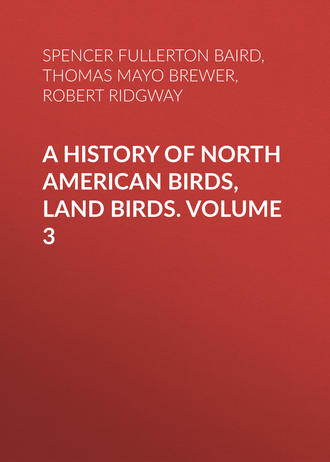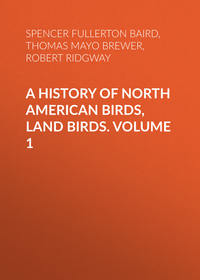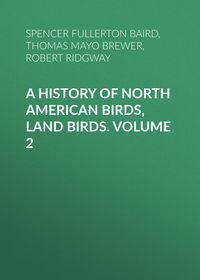 полная версия
полная версияПолная версия
A History of North American Birds, Land Birds. Volume 3
The true wild bird of eastern North America always has the tips of the tail-feathers and upper tail-covert of a chestnut-brown color; the Mexican species and its descendant of the barnyard never exhibit this feature.
Sometimes this domesticated bird is exactly like its wild original, differing only in rather greater development of the fatty lobes of the head and neck; and of this an example may be seen in the Museum of the Smithsonian Institution.
There is a variety of the domestic bird which is entirely black, sometimes even including the larger quills, which in both species are naturally banded with white, and in this there may be little or no trace of any bands at the end of the tail and of its upper coverts; but whatever may be the asseverations of the sportsman, the poultry-dealer, or the farmer, as to the “wildness” of any particular bird, or what the circumstances attendant upon its capture or death by trapping, shooting, or otherwise, implicit confidence may be placed in the test above indicated, namely: if the tips of tail and tail-covert are chestnut-brown, the specimen belongs to the M. gallopavo or “Wild Turkey”; if the same part is either entirely black or any shade of whitish or light fulvous, then it is a “barnyard” fowl.
The following extract from a letter written by Dr. Sartorius, the accomplished naturalist, to whom the Smithsonian Institution owes the specimen of the wild Mexican bird referred to above, will be read with interest.
“Mirador, State of Vera Cruz,
January 20, 1867.
“I am entirely of your opinion in regard to the origin of the domestic Turkey, as our wild bird differs from the tame only in the less amount of development of the fatty lobes of the head and neck.
“Meleagris mexicana is tolerably abundant in this neighborhood, belonging more especially to the sparsely overgrown savannas between the region of the oaks and the coast, the Tierra Caliente or ‘warm region’ proper. It is a very shy bird, living in families like the wild Geese, and keeping sentinels on the watch whenever the flock is feeding in the vicinity of threatened danger. It derives its nourishment from plants and insects on the ground, and scratches with its feet to aid in the search for food. In running, the swiftest dog cannot overtake it. It is not very fond of taking to flight, but its powers in this respect are not behind those of any of the allied forms. Its breeding-season is in March or April, when the hens separate from the males to reunite into families again in September. Their general habits during this season are much as with the domestic bird, although I cannot say whether they inflate and swell themselves out in the same manner. I am, however, inclined to doubt it, as the specimen I have handled did not have the tips of the wing-feathers worn away as in the barn-yard breed. The female lays from three to twelve brownish-red, spotted eggs in the high grain, and hatches them out in thirty days, as is the case with the tame Turkey. The flesh of the wild bird is dry, but very sweet, like the tame fowl, and like the latter is dark on the back and legs, and white on the breast and wings.
“The white meat of the flesh on the breast of the Mexican and the tame Turkey, as compared with the darker meat of the common North American wild bird, is a fact of importance to be taken into consideration.
“The exact distribution of the Mexican Wild Turkey southward and westward is not ascertained, nor is it known that it occupies the western portion of the Mexican country. In Yucatan and Northern Guatemala it is replaced by a third species, the Ocellated Turkey (Meleagris ocellata), rather less in size, but far more striking in appearance, being marked in the tail with spots somewhat like the ‘eyes’ of the tail of the Peacock. The three species thus belong to Mexico and northern parts of Central America.
“Very truly yours,“C. SARTORIUS.”115
Ortyx virginianus, var. cubanensis. Ortyx cubanensis, “Gould.”—Gray & Mitch. Gen. III, 514. Ortyx, sp. 2.—Gould, Mon. Odont.
116
The Florida bird has been lately characterized as var. floridanus by Dr. Coues, in his Key to North American Birds.
117
Cyrtonyx ocellatus, Gould, P. Z. S. IV, p. 78.—Ib. Monog. Odont.
118
This specimen is the type of C. ochrocephalus, Aiken, Am. Nat. VII, April, 1873, p. 236.





